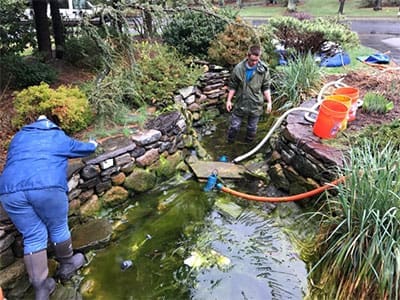Algae are a natural part of aquatic ecosystems, but unchecked growth can lead to imbalances in your pond and diminish its aesthetic appeal. New England Aquatic Landscapes is here to guide you through the process of effectively managing and eliminating algae to ensure your pond remains a healthy and beautiful haven for all its inhabitants.
- Identifying Algae in Your Pond There are two main types of pond algae that you may encounter:
Microscopic algae: These single-celled organisms are invisible to the naked eye and can cause green or brown water. They typically grow rapidly and can reduce oxygen levels in your pond.
Filamentous algae: This type of algae appears as stringy, hair-like strands that can clump together and float on the pond’s surface. They often start growing along the pond’s edges and can spread quickly.
- Pinpointing the Causes of Algae Growth Understanding the factors contributing to algae growth in your pond is crucial for effective control. Common causes include:
Excess nutrients: High levels of nutrients, such as nitrogen and phosphorus, can promote rapid algae growth. These nutrients often come from fertilizer runoff, decomposing plant material, and fish waste.
Sunlight: Algae require sunlight to grow, so ponds with a lot of direct sunlight may be more susceptible to algae blooms.
Low oxygen levels: Stagnant water and insufficient oxygen can contribute to algae growth by promoting the decomposition of organic material, which releases more nutrients.
- Preventative Measures for Algae Growth To proactively prevent algae growth in your pond, follow these guidelines:
Achieve balance: Ensure your pond has an appropriate balance of fish, plants, and beneficial bacteria to help regulate nutrient levels naturally.
Reduce sunlight exposure: Introduce floating plants or strategically place landscape elements to provide shade and limit algae growth.
Enhance aeration: Add a pond aerator or waterfall to increase oxygen levels and promote water circulation.
Invest in proper filtration: Use a high-quality pond filtration system to remove excess nutrients and debris.
- Controlling and Eliminating Algae If you’re already dealing with algae in your pond, implement these methods to control and eliminate it:
Manual removal: Use a rake or skimmer net to physically remove large clumps of filamentous algae.
Algaecides: Apply algaecides specifically designed for ponds, following the manufacturer’s instructions carefully to avoid harming fish and plants.
Introduce beneficial bacteria: Add beneficial bacteria products to consume excess nutrients and break down organic waste, thereby limiting resources available for algae growth.
Utilize barley straw: Place barley straw in a mesh bag and submerge it in the pond. As it decomposes, it releases compounds that help inhibit algae growth.
- Professional Assistance from New England Aquatic Landscapes If you’re struggling to manage algae in your pond or require expert guidance, consider reaching out to New England Aquatic Landscapes. Our team of experienced professionals can assess your pond’s specific needs and recommend the most effective solutions for maintaining a healthy and visually appealing aquatic environment.
Effectively managing and eliminating pond algae is crucial for maintaining a balanced and thriving aquatic landscape. By understanding the causes of algae growth and implementing preventive measures and treatments, you can enjoy a vibrant and flourishing pond ecosystem. For any assistance or guidance, New England Aquatic Landscapes is always here to help.




